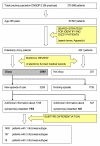Dizziness reported by elderly patients in family practice: prevalence, incidence, and clinical characteristics
- PMID: 20064231
- PMCID: PMC2817676
- DOI: 10.1186/1471-2296-11-2
Dizziness reported by elderly patients in family practice: prevalence, incidence, and clinical characteristics
Abstract
Background: Although dizziness in elderly patients is very common in family practice, most prevalence studies on dizziness are community-based and include a study population that is not representative of family practice. The aim of this study was to investigate the prevalence and incidence of dizziness reported by elderly patients in family practice, to describe their final diagnoses as recorded by the family physician, and to compare the clinical characteristics of dizzy patients with those of non-dizzy patients.
Methods: Data were obtained from the Second Dutch National Survey of General Practice, a prospective registration study which took place over a 12-month period in 2001. We developed a search strategy consisting of 15 truncated search terms (based on Dutch synonyms for dizziness), and identified all patients aged 65 or older who visited their family physician because of dizziness (N = 3,990). We used the mid-time population as denominator to calculate the prevalence and incidence, and for group comparisons we used the Student's t and Chi-square test, and logistic regression analysis.
Results: The one-year prevalence of dizziness in family practice in patients aged 65 or older was 8.3%, it was higher in women than in men, and it increased with age. In patients aged 85 or older the prevalence was similar for men and women. The incidence of dizziness was 47.1 per 1000 person-years. For 39% of the dizzy patients the family physicians did not specify a diagnosis, and recorded a symptom diagnosis as the final diagnosis. Living alone, lower level of education, pre-existing cerebrovascular disease, and pre-existing hypertension were independently associated with dizziness.
Conclusions: Dizziness in family practice patients increases with age. It is more common in women than in men, but this gender difference disappears in the very old. Because a large proportion of dizzy elderly patients in family practice remains undiagnosed, it would be worthwhile to carry out more diagnostic research on dizziness in a family practice setting.
Figures
References
-
- Aggarwal NT, Bennett DA, Bienias JL, Mendes de Leon CF, Morris MC, Evans DA. The prevalence of dizziness and its association with functional disability in a biracial community population. J Gerontol A Biol Sci Med Sci. 2000;55:M288–M292. - PubMed
-
- Jonsson R, Sixt E, Landahl S, Rosenhall U. Prevalence of dizziness and vertigo in an urban elderly population. J Vestib Res. 2004;14:47–52. - PubMed
-
- Sloane P, Blazer D, George LK. Dizziness in a community elderly population. J Am Geriatr Soc. 1989;37:101–108. - PubMed
-
- Tilvis RS, Hakala SM, Valvanne J, Erkinjuntti T. Postural hypotension and dizziness in a general aged population: a four-year follow-up of the Helsinki Aging Study. J Am Geriatr Soc. 1996;44:809–814. - PubMed
Publication types
MeSH terms
LinkOut - more resources
Full Text Sources
Medical


